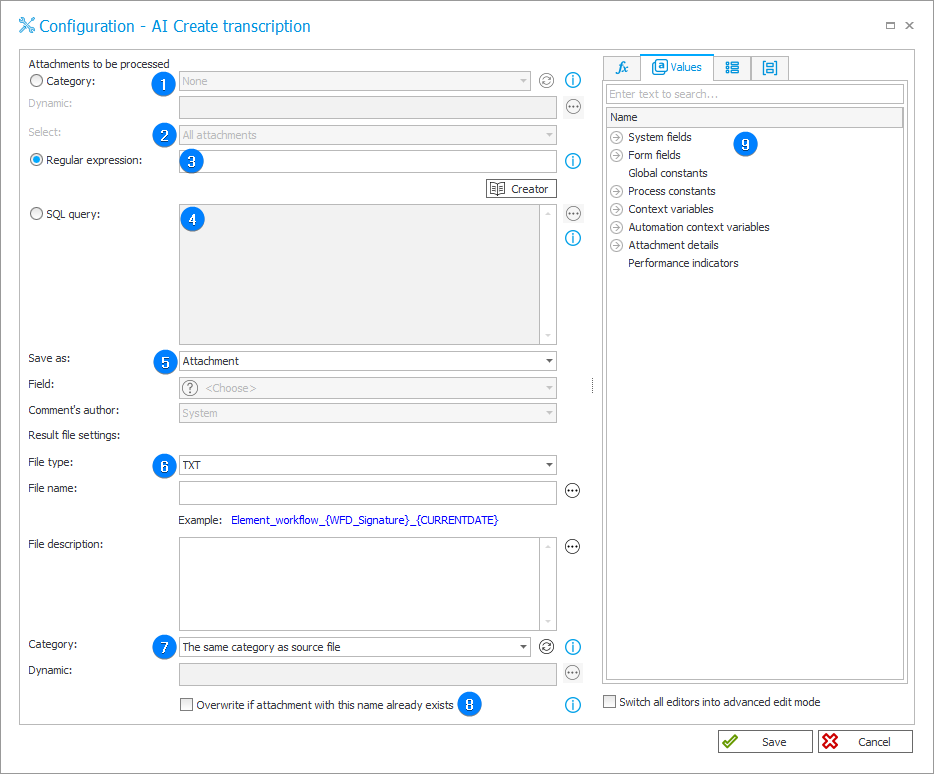AI Create transcription
The action uses artificial intelligence to create a transcription of the audio recording attached to the workflow instance. The resulting transcription of the voice memo can then be saved as a form field value or as a text file attachment.
Availability of this action depends on having an additional dedicated license.

Attachments to be processed
1. Category
The field allows you to specify the attachment category by which files will be searched.
In addition to the categories defined by the designer in the process configuration, built-in options are available:
- All – search attachments that belong to all categories.
- Dynamic – dynamically construct a category (using variables from the editor) or enter it manually. The category can be provided in BPS format (i.e. "ID#Name") or just the "ID". Attachments belonging to the category will be selected based on their ID.
If searching by ID returns no results, the entered phrase will be treated as a name of a custom category (a category from outside the data source), and attachments belonging to this category will be returned. - None – search attachments that do not belong to any category.
2. Select
The field allows you to specify the format of the attachments to be processed. You can use the drop-down list and specify one of the three available options: All attachments (all attachments with a supported extension will be processed, i.e. .wav, .mp3, .aac, .ogg vorbis, and .flac files), The oldest attachment (only the attachment added first will be processed), or The newest attachment (only the attachment added last will be processed).
3. Regular expression
Here you can define a regular expression that will be used to select attachments for processing. The RegExLib Wizard can be used to create the expression by pressing the Creator button shown below the field.
4. SQL query
If this option is checked, the attachments to be processed are selected based on an SQL query. The query should return a list of attachment IDs from the "WFDataAttachmets" table.
Select [ATT_ID] from [WFDataAttachmets] Where [ATT_Name] = 'file.docx'
Saving the transcription
5. Save as
Choose whether to save the transcription of the recording as a Multiple lines of text, Comment, or as an attachment.
- Field – the field is active if you have chosen to save the transcription as a Field value. All Multiple lines of text fields and the Comment available for the workflow instance are suggested here.
- Comment's author – the field is active if you have chosen to save the transcription as a comment. The author of the comment can be System or Current user.
Target file settings
6. Target file parameters
- File type – option to select the format in which the resulting text file will be saved. Available extensions: .txt, .docx, .pdf, .pdf/a.
- File name – field in which you can specify the name of the resulting file. The name can contain references to other elements, including form fields or system fields.
Element_workflow_{WFD_Signature}_{CURRENTDATE}
- File description – optional description of the resulting file. The description can contain references to other elements, including form fields or system fields.
7. Target file category
Specify a category to which the transcription file will be saved. In addition to the categories defined in the process configuration, the following options are available:
- The same category as source file – the attachment will be saved with the same category as the source file.
- Dynamic – dynamically construct a category (using variables from the editor) or enter it manually. The category can be provided in BPS format (i.e. "ID#Name") or just the "ID". In this mode, it is possible to enter a category from within or outside the data source.
If the category is provided in ID#Name format, the source must contain a category with the provided ID. If such a category is not found, the action will result in an error.
If the category is provided as the ID only, and it is not found in the source, the entered phrase will be treated as a name of a custom category (a category from outside the data source). - None – the attachment will be saved without a category.
8. Overwrite if attachment with this name already exists
If this option is enabled, the category of the resulting file selected in the action configuration is ignored. The overwritten file will remain in the same category as its previous version. A new historical version of the file is created.
9. Variables editor
Dynamically generated tree containing all variables that may be used in the current location of Designer Studio. Information on how to use variables in WEBCON BPS, as well as a list of variables can be found here.
For more information, see the article New AI solutions in WEBCON BPS on our technical blog.